charge Hyundai Ioniq Electric 2019 Workshop Manual
[x] Cancel search | Manufacturer: HYUNDAI, Model Year: 2019, Model line: Ioniq Electric, Model: Hyundai Ioniq Electric 2019Pages: 555, PDF Size: 20.1 MB
Page 444 of 555

7-47
7
Maintenance
Fuse NameFuse RatingProtected Component
MODULE510AElectro Chromic Mirror, Audio, Driver IMS Module, Rear Seat Warmer Module, DBL Unit, VESS Unit,
Front Seat Warmer Control Module, Head Lamp LH/RH, Front Air Ventilation Seat Control Module
MODULE410ALane Keeping Assist Unit, Crash Pad Switch, Electric Parking Brake Unit FCA Unit,
Blind-spot Collision Warning (BCW) Radar LH/RH
INTERIORLAMP10AFront Vanity Lamp LH/RH, Room Lamp, Overhead Console Lamp, Luggage Lamp, Wireless Charger Unit
A/BAG 15ASRS Control Module, Occupant Detection Sensor
E-SHIFTER110ASBW Switch, Front Console Switch
IG125APCB Block (Fuse - AHB3, EPCU2)
CLUSTER10AInstrument Cluster
MODULE310ABCM, Stop Lamp Switch, Driver Door Module, Passenger Door Module
IG3 210AIPS Control Module, Main Battery Charging Switch, Charge Lamp, PTC Heater,
A/V & Navigation Head Unit, Instrument Cluster, A/C Control Module, Audio
MEMORY27.5AActive Air Flap
A/BAG IND7.5AInstrument Cluster
START7.5AEPCU, Smart Key Control Module
Instrument panel fuse panel
Page 445 of 555
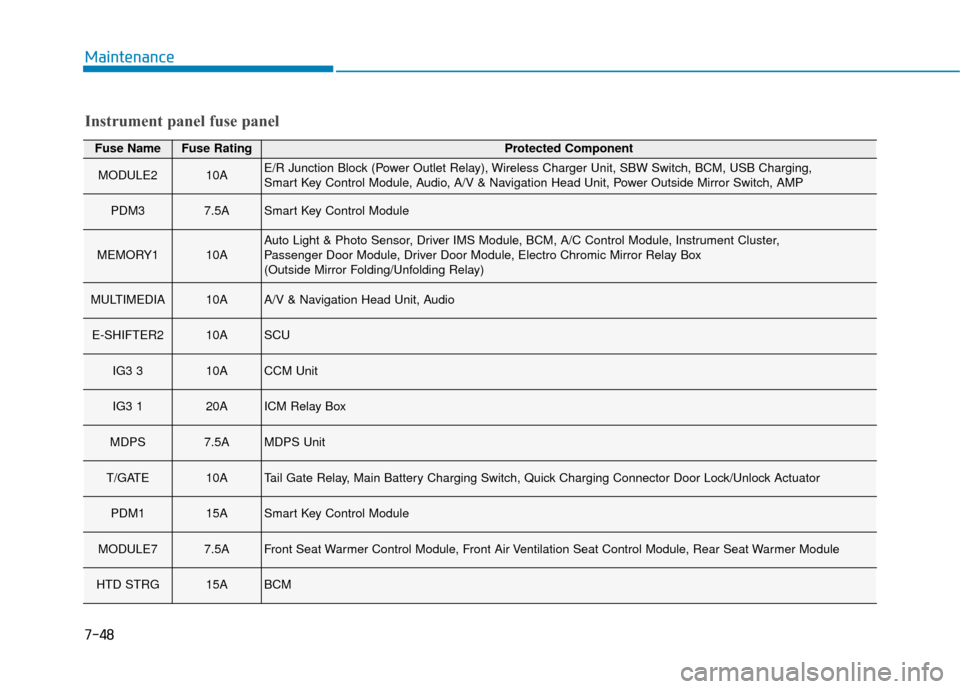
7-48
Maintenance
Fuse NameFuse RatingProtected Component
MODULE210AE/R Junction Block (Power Outlet Relay), Wireless Charger Unit, SBW Switch, BCM, USB Charging,
Smart Key Control Module, Audio, A/V & Navigation Head Unit, Power Outside Mirror Switch, AMP
PDM37.5ASmart Key Control Module
MEMORY110AAuto Light & Photo Sensor, Driver IMS Module, BCM, A/C Control Module, Instrument Cluster,
Passenger Door Module, Driver Door Module, Electro Chromic Mirror Relay Box
(Outside Mirror Folding/Unfolding Relay)
MULTIMEDIA10AA/V & Navigation Head Unit, Audio
E-SHIFTER210ASCU
IG3 310ACCM Unit
IG3 120AICM Relay Box
MDPS7.5AMDPS Unit
T/GATE10ATail Gate Relay, Main Battery Charging Switch, Quick Charging Connector Door Lock/Unlock Actuator
PDM115ASmart Key Control Module
MODULE77.5AFront Seat Warmer Control Module, Front Air Ventilation Seat Control Module, Rear Seat Warmer Module
HTD STRG15ABCM
Instrument panel fuse panel
Page 446 of 555
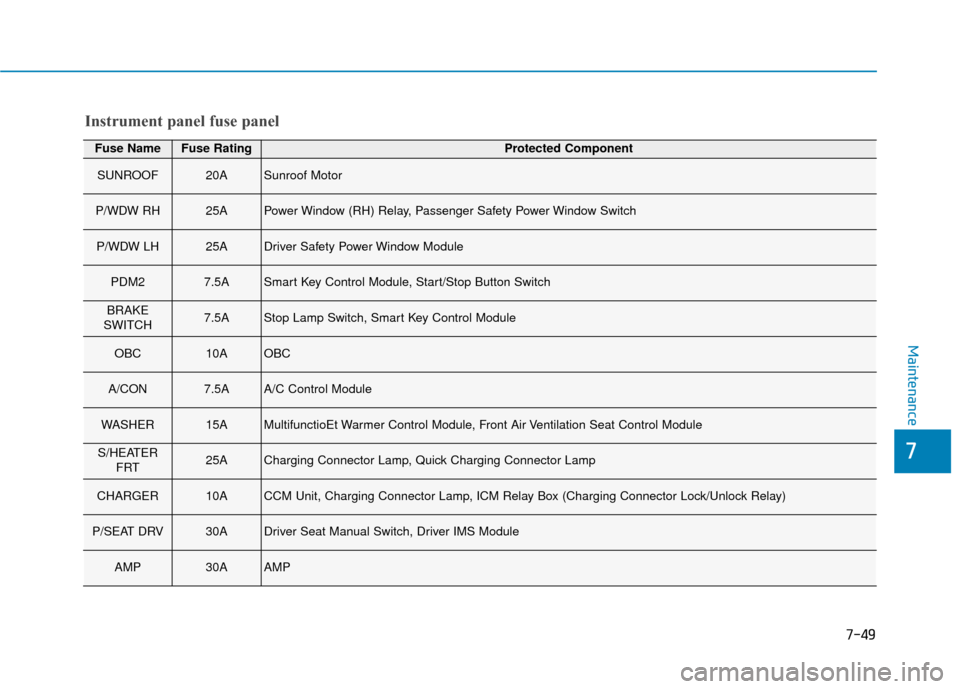
7-49
7
Maintenance
Fuse NameFuse RatingProtected Component
SUNROOF20ASunroof Motor
P/WDW RH25APower Window (RH) Relay, Passenger Safety Power Window Switch
P/WDW LH25ADriver Safety Power Window Module
PDM27.5ASmart Key Control Module, Start/Stop Button Switch
BRAKE
SWITCH7.5AStop Lamp Switch, Smart Key Control Module
OBC10AOBC
A/CON7.5AA/C Control Module
WASHER15AMultifunctioEt Warmer Control Module, Front Air Ventilation Seat Control Module
S/HEATER FRT25ACharging Connector Lamp, Quick Charging Connector Lamp
CHARGER10ACCM Unit, Charging Connector Lamp, ICM Relay Box (Charging Connector Lock/Unlock Relay)
P/SEAT DRV30ADriver Seat Manual Switch, Driver IMS Module
AMP30AAMP
Instrument panel fuse panel
Page 449 of 555
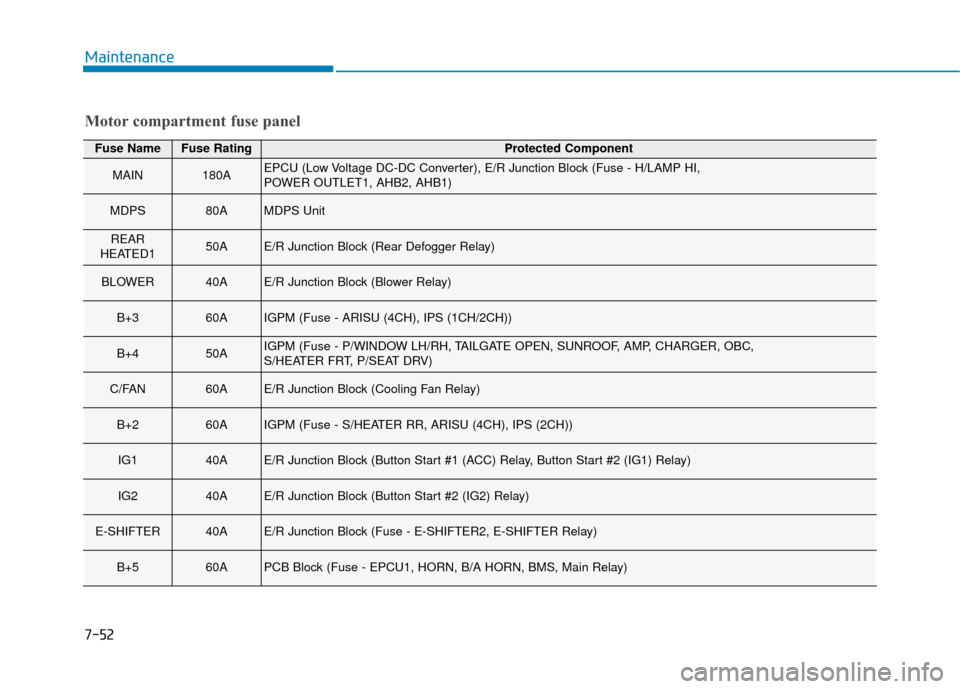
7-52
Maintenance
Motor compartment fuse panel
Fuse NameFuse RatingProtected Component
MAIN180AEPCU (Low Voltage DC-DC Converter), E/R Junction Block (Fuse - H/LAMP HI,
POWER OUTLET1, AHB2, AHB1)
MDPS80AMDPS Unit
REAR
HEATED150AE/R Junction Block (Rear Defogger Relay)
BLOWER40AE/R Junction Block (Blower Relay)
B+360AIGPM (Fuse - ARISU (4CH), IPS (1CH/2CH))
B+450AIGPM (Fuse - P/WINDOW LH/RH, TAILGATE OPEN, SUNROOF, AMP, CHARGER, OBC,
S/HEATER FRT, P/SEAT DRV)
C/FAN60AE/R Junction Block (Cooling Fan Relay)
B+260AIGPM (Fuse - S/HEATER RR, ARISU (4CH), IPS (2CH))
IG140AE/R Junction Block (Button Start #1 (ACC) Relay, Button Start #2 (IG1) Relay)
IG240AE/R Junction Block (Button Start #2 (IG2) Relay)
E-SHIFTER40AE/R Junction Block (Fuse - E-SHIFTER2, E-SHIFTER Relay)
B+560APCB Block (Fuse - EPCU1, HORN, B/A HORN, BMS, Main Relay)
Page 472 of 555
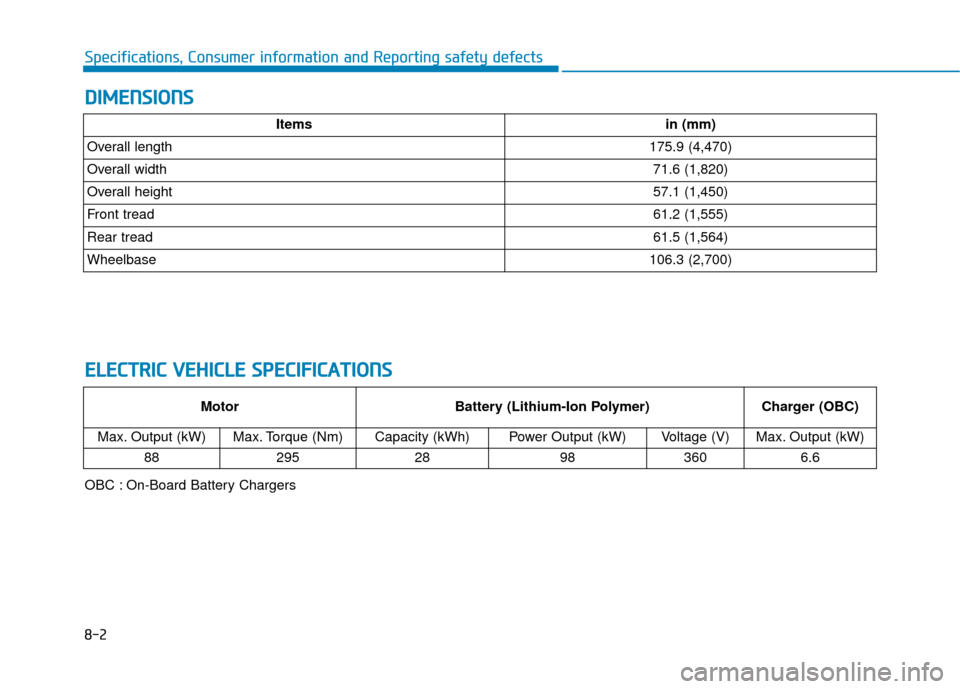
D
DI
IM
M E
EN
N S
SI
IO
O N
NS
S
8-2
Specifications, Consumer information and Reporting safety defects
Itemsin (mm)
Overall length175.9 (4,470)
Overall width71.6 (1,820)
Overall height57.1 (1,450)
Front tread61.2 (1,555)
Rear tread 61.5 (1,564)
Wheelbase106.3 (2,700)
E
EL
LE
E C
CT
T R
R I
IC
C
V
V E
EH
H I
IC
C L
LE
E
S
S P
P E
EC
CI
IF
F I
IC
C A
A T
TI
IO
O N
NS
S
Motor Battery (Lithium-Ion Polymer)Charger (OBC)
Max. Output (kW)
Max. Torque (Nm) Capacity (kWh)Power Output (kW)Voltage (V)Max. Output (kW)
88
295 28983606.6
OBC : On-Board Battery Chargers
Page 481 of 555
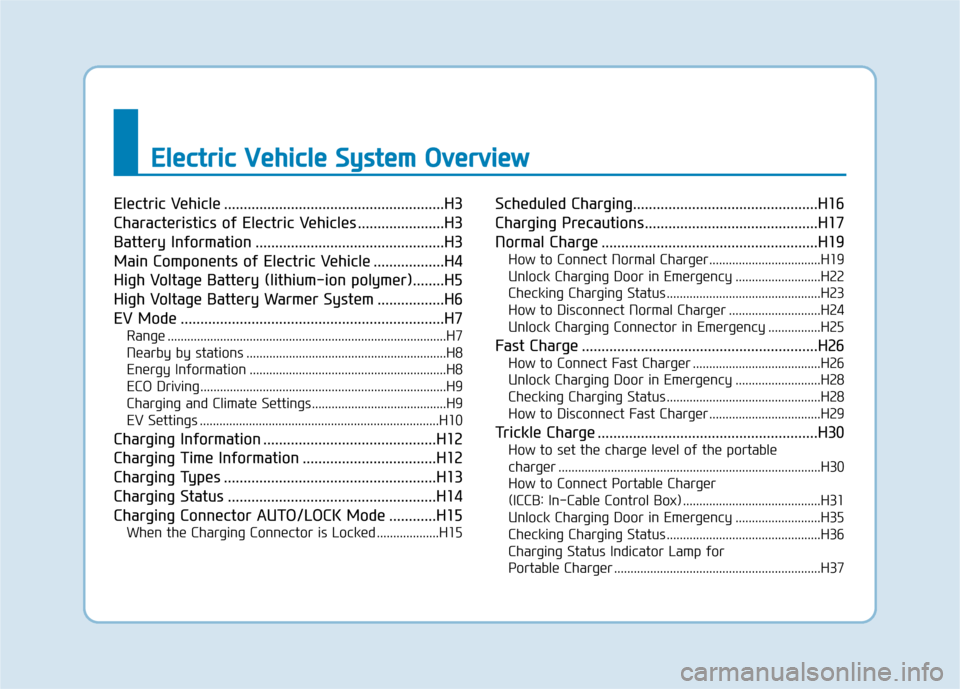
E
El
le
e c
ct
tr
r i
ic
c
V
V e
eh
h i
ic
c l
le
e
S
S y
ys
st
te
e m
m
O
O v
ve
e r
rv
v i
ie
e w
w
Electric Vehicle ........................................................H3
Characteristics of Electric Vehicles ......................H3
Battery Information ................................................H3
Main Components of Electric Vehicle ..................H4
High Voltage Battery (lithium-ion polymer)........H5
High Voltage Battery Warmer System .................H6
EV Mode ...................................................................H7
Range ........................................................................\
.............H7
Nearby by stations .............................................................H8
Energy Information ............................................................H8
ECO Driving ........................................................................\
...H9
Charging and Climate Settings.........................................H9
EV Settings ........................................................................\
.H10
Charging Information ............................................H12
Charging Time Information ..................................H12
Charging Types ......................................................H13
Charging Status .....................................................H14
Charging Connector AUTO/LOCK Mode ............H15
When the Charging Connector is Locked ...................H15
Scheduled Charging...............................................H16
Charging Precautions............................................H17
Normal Charge .......................................................H19
How to Connect Normal Charger..................................H19
Unlock Charging Door in Emergency ..........................H22
Checking Charging Status ...............................................H23
How to Disconnect Normal Charger ............................H24
Unlock Charging Connector in Emergency ................H25
Fast Charge ............................................................H26
How to Connect Fast Charger .......................................H26
Unlock Charging Door in Emergency ..........................H28
Checking Charging Status ...............................................H28
How to Disconnect Fast Charger ..................................H29
Trickle Charge ........................................................H30
How to set the charge level of the portable
charger ........................................................................\
........H30
How to Connect Portable Charger
(ICCB: In-Cable Control Box) ..........................................H31
Unlock Charging Door in Emergency ..........................H35
Checking Charging Status ...............................................H36
Charging Status Indicator Lamp for
Portable Charger ...............................................................H37
Page 482 of 555

How to Disconnect Portable Charger
(ICCB: In-Cable Control Box) ..........................................H40
Unlock Charging Connector in Emergency ................H41
Precautions for Portable Charger
(ICCB: In-Cable Control Box) ..........................................H41
How to Start the Vehicle ......................................H42
How to Stop the Vehicle.......................................H42
Virtual Engine Sound System ..............................H43
Distance to Empty .................................................H43
When destination is not set ...........................................H44
When destination is set...................................................H44
Tips for Improving Distance to Empty ...............H45
ECO Guide ...............................................................H45
State of Charge (SOC) Gauge for
High Voltage Battery ............................................H46
Warning and Indicator Lights
(related to electric vehicle) .................................H46
Ready Indicator .................................................................H46
Service Warning Light .....................................................H47
Power Down Warning Light ...........................................H47
Charging Indicator Light..................................................H47
High Voltage Battery Level Warning Light .................H48
Regenerative Brake Warning Light ..............................H48
LCD Display Messages ..........................................H48
Shift to P to charge .........................................................H48
Remaining time ..................................................................H49 Charging Door Open ........................................................H49
Charger Error! / Quick Charger Error!........................H49
Stop vehicle and check brakes .....................................H50
Check brakes......................................................................H5\
0
Low Battery........................................................................\
H50
Charge immediately. Power limited ..............................H51
Low Battery. Charge immediately.................................H51
Low Battery Temp. Power limited.................................H51
Battery Overheated! Stop vehicle ................................H52
Power limited .....................................................................H52\
Stop vehicle and check power supply .........................H53
Check Virtual Engine Sound System............................H53
Check electric vehicle system .......................................H54
Energy Flow ...........................................................H54
Vehicle Stop........................................................................\
H54
EV Propulsion ....................................................................H55
Regeneration ......................................................................H5\
5
Aux. Battery Saver+ .............................................H55
Mode ........................................................................\
............H56
System Setting...................................................................H57
LCD Message .....................................................................H57\
If an Accident Occurs ...........................................H58
Other Precautions for Electric Vehicle ..............H60
Service Plug ...........................................................H61
Page 483 of 555

H3
Electric Vehicle
An electric vehicle is driven using a
battery and an electric motor. While
general vehicles use an internal
combustion engine and gasoline as
fuel, electric vehicles use electrical
energy that is charged inside the
high voltage battery. As a result,
electric vehicles are eco-friendly in
that they do not require fuel and do
not emit exhaust gases.
Characteristics of Electric
Vehicles
1. It is driven using the electricalenergy that is charged inside the
high voltage battery. This method
prevents air pollution since fuel,
like gasoline, is not required,
negating the emission of exhaust
gases.
2. A high performance motor is used in the vehicle as well. Compared
to standard, internal combustion
engine vehicles, engine noise and
vibrations are much more minimal
when driving.
3. When decelerating or driving downhill, regenerative braking is
utilized to charge the high voltage
battery. This minimizes energy
loss and increases the distance to
empty.
4. When the battery charge is not sufficient, normal charge, quick
charge and trickle charge are
available. (Refer to "Charge Types
for Electric Vehicle" for details.)
Information
What does regenerative braking do?
It uses the electric motor when decel-
erating or braking which transforms
vehicle motion (kinetic energy) to elec-
trical energy to charge the high volt-
age batteries. (Torque is applied in the
opposite direction when decelerating
to generate braking force and electric
energy.)
Battery Information
• The vehicle is composed of a highvoltage battery that drives the
motor and air-conditioner, and an
auxiliary battery (12 V) that drives
the lamps, wipers, and audio sys-
tem.
The auxiliary battery is automati- cally charged when the vehicle is in
the ready ( ) mode or the high
voltage battery is being charged.
i
E
EL
LE
E C
CT
T R
R I
IC
C
V
V E
EH
H I
IC
C L
LE
E
Page 484 of 555
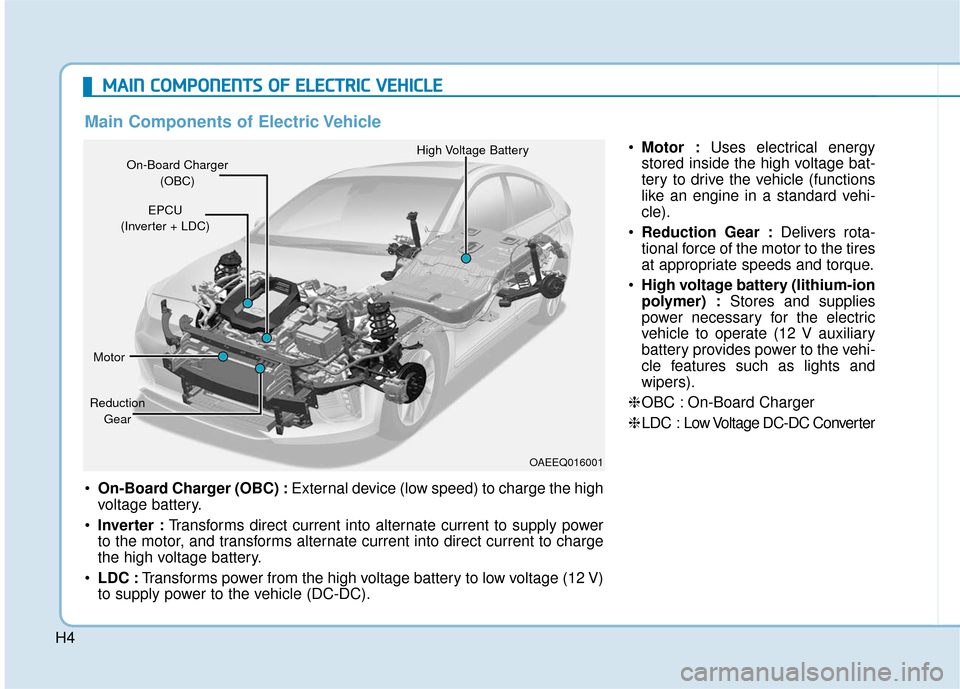
H4
M
MA
AI
IN
N
C
C O
O M
M P
PO
O N
NE
EN
N T
TS
S
O
O F
F
E
E L
LE
E C
CT
T R
R I
IC
C
V
V E
EH
H I
IC
C L
LE
E
On-Board Charger (OBC) : External device (low speed) to charge the high
voltage battery.
Inverter : Transforms direct current into alternate current to supply power
to the motor, and transforms alternate current into direct current to charge
the high voltage battery.
LDC : Transforms power from the high voltage battery to low voltage (12 V)
to supply power to the vehicle (DC-DC).
On-Board Charger
(OBC) High Voltage Battery
EPCU
(Inverter + LDC)
Motor
Reduction Gear
Main Components of Electric Vehicle
Motor : Uses electrical energy
stored inside the high voltage bat-
tery to drive the vehicle (functions
like an engine in a standard vehi-
cle).
Reduction Gear : Delivers rota-
tional force of the motor to the tires
at appropriate speeds and torque.
High voltage battery (lithium-ion
polymer) : Stores and supplies
power necessary for the electric
vehicle to operate (12 V auxiliary
battery provides power to the vehi-
cle features such as lights and
wipers).
❈ OBC : On-Board Charger
❈ LDC : Low V oltage DC-DC Converter
OAEEQ016001
Page 485 of 555
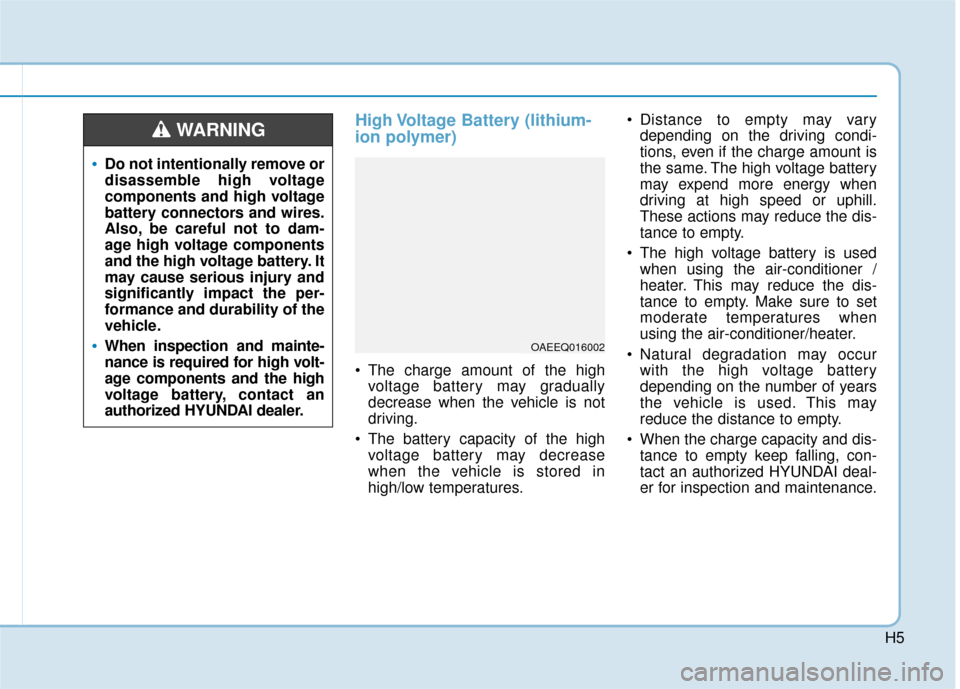
H5
High Voltage Battery (lithium-
ion polymer)
The charge amount of the highvoltage battery may gradually
decrease when the vehicle is not
driving.
The battery capacity of the high voltage battery may decrease
when the vehicle is stored in
high/low temperatures. Distance to empty may vary
depending on the driving condi-
tions, even if the charge amount is
the same. The high voltage battery
may expend more energy when
driving at high speed or uphill.
These actions may reduce the dis-
tance to empty.
The high voltage battery is used when using the air-conditioner /
heater. This may reduce the dis-
tance to empty. Make sure to set
moderate temperatures when
using the air-conditioner/heater.
Natural degradation may occur with the high voltage battery
depending on the number of years
the vehicle is used. This may
reduce the distance to empty.
When the charge capacity and dis- tance to empty keep falling, con-
tact an authorized HYUNDAI deal-
er for inspection and maintenance.
•Do not intentionally remove or
disassemble high voltage
components and high voltage
battery connectors and wires.
Also, be careful not to dam-
age high voltage components
and the high voltage battery. It
may cause serious injury and
significantly impact the per-
formance and durability of the
vehicle.
When inspection and mainte-
nance is required for high volt-
age components and the high
voltage battery, contact an
authorized HYUNDAI dealer.
WARNING
OAEEQ016002